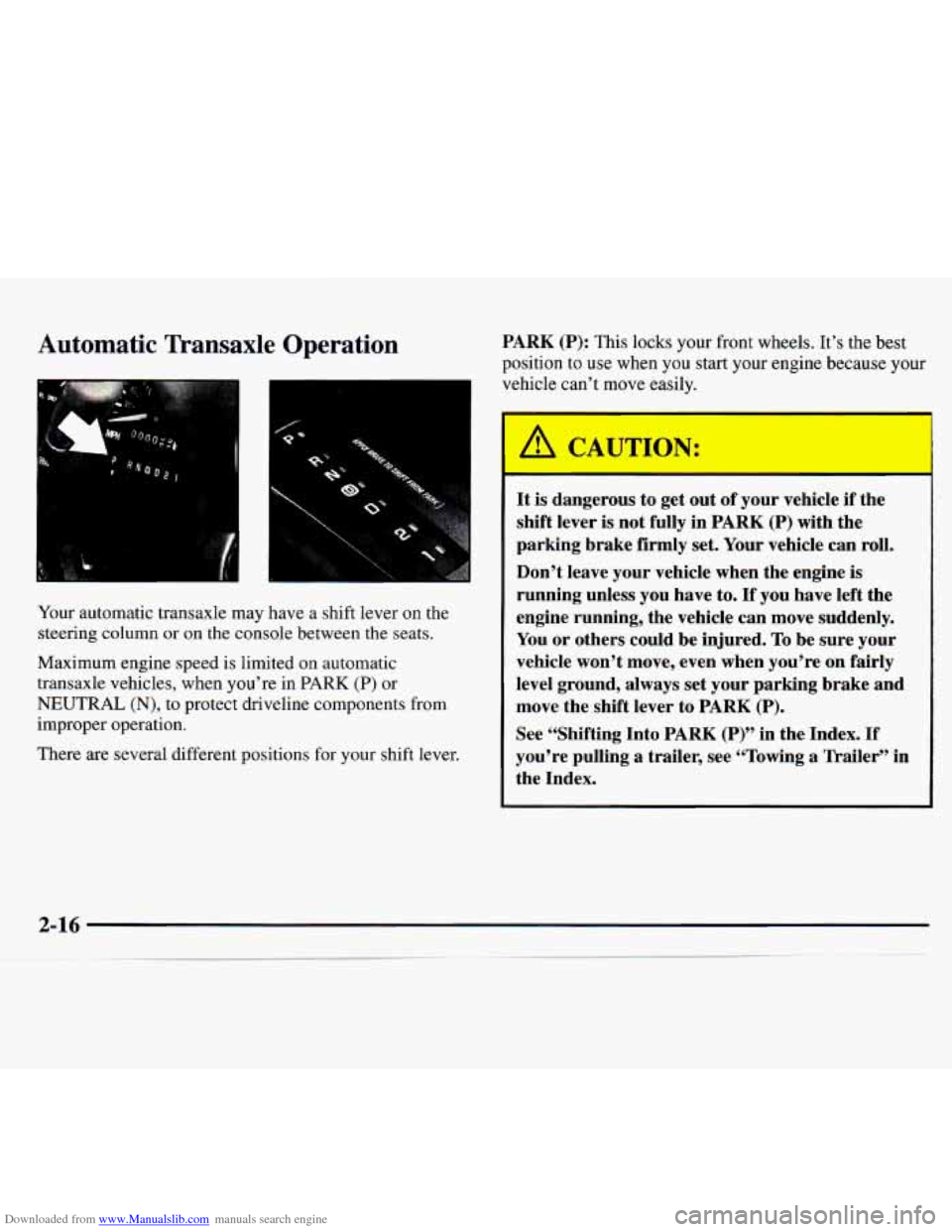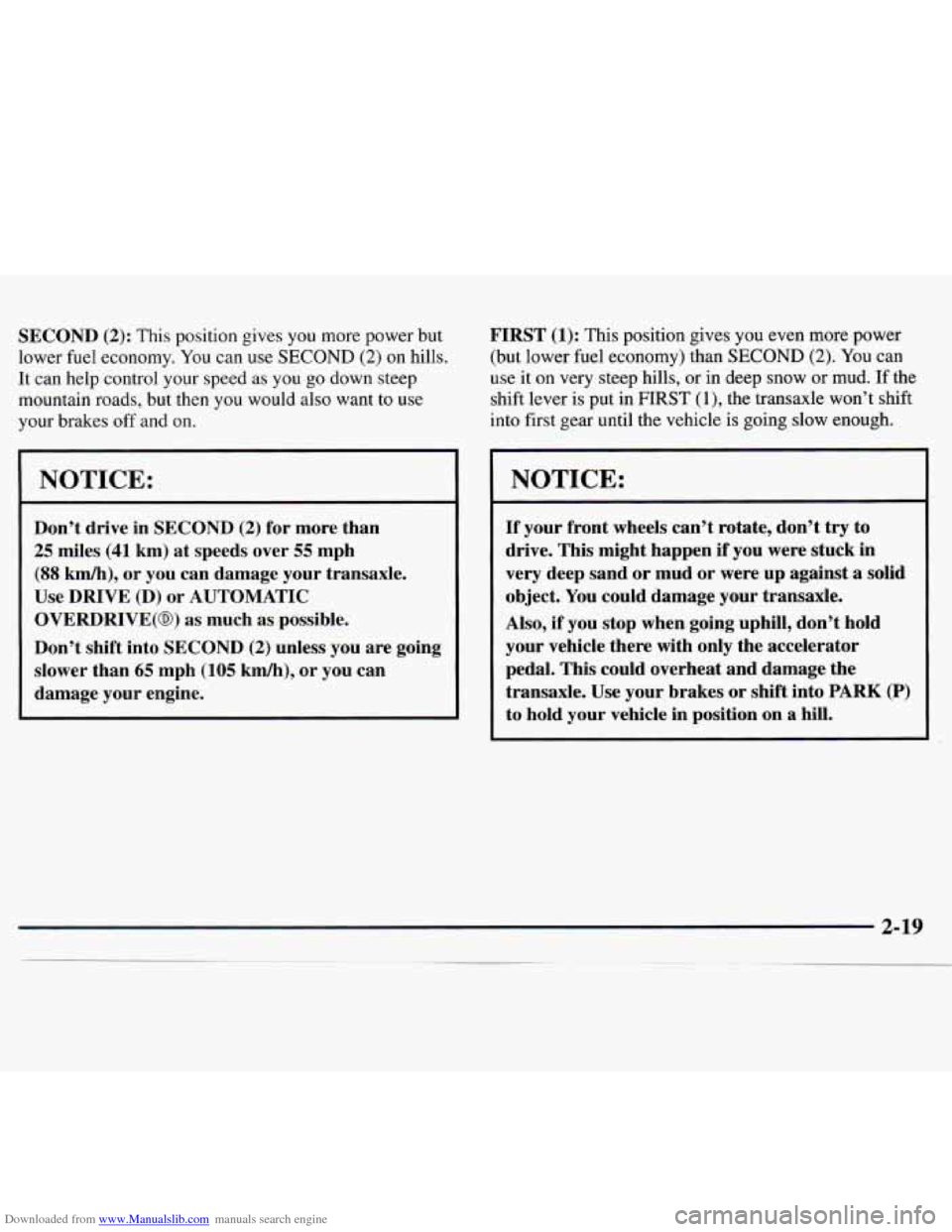Page 68 of 358

Downloaded from www.Manualslib.com manuals search engine Trunk Lock
To unlock the trunk from
the outside, insert the door
key and turn it. You can
also use the remote keyless
entry function if your
vehicle has this option.
Just press the trunk symbol
on the transmitter, making
sure your shift lever is in
PARK
(P).
Remote Trunk Release (Option)
Press the button under the
instrument panel on the
driver’s side. Your transaxle
shift lever must be in
PARK (P).
Remember, your trunk can be opened at any time using
this lock release,
so be sure to lock your doors.
Theft
Vehicle theft is big business, especially in some
cities. Although your Chevrolet has
a number of
theft-deterrent features, we know that nothing we put
on it can make
it impossible to steal. However, there are
ways you can help.
Key in the Ignition
If you leave your vehicle with the keys inside, it’s an
easy target for joy riders or professional thieves
-- so
don’t do it.
When ydu @ark your Chevrolet and open the driver’s
door, you’ll hear a chime reminding you to remove your
key from the ignition and take it with you. Always
do
this. Your steering wheel will be locked, and so will
your ignition and transaxle. And remember
to lock
the doors.
Page 71 of 358

Downloaded from www.Manualslib.com manuals search engine New Vehicle “Break-In” Ignition Positions
NOTICE:
Your modern Chevrolet doesn’t need an
elaborate “break-in.” But
it will perform better
in the long run
if you follow these guidelines:
0
0
0
Don’t drive at any one speed -- fast or
slow
-- for the first 500 miles (805 km).
Don’t make full-throttle
starts.
Avoid making hard stops for the first
200 miles (322 km) or so. During this time
your new brake linings aren’t yet broken
in. Hard stops with new linings can mean
premature wear and earlier replacement.
Follow this breaking-in guideline every
time
you get new brake linings.
Don’t tow
a trailer during break-in.
See “Towing a Trailer” in the Index for
more information.
A 1 E
With the ignition key in the ignition switch, you can turn
the switch to five positions:
ACC (A): This position lets you use things like the
radio and windshield wipers when the engine is
off. To
use ACC, push in the key and turn it toward you. Your
steering wheel will stay locked.
LOCK (B): Before you put the key into the ignition
switch, the switch is in
LOCK. It’s also the only position
in which you can remove your key. This position locks
your ignition, steering wheel and transaxle. It’s
a
theft-deterrent feature.
Page 72 of 358

Downloaded from www.Manualslib.com manuals search engine OFF (C): This position lets you turn off the engine but
still turn the steering wheel. It doesn’t lock the steering
wheel like LOCK. Use
OFF if you must have your
vehicle pushed or towed.
RUN (D): This position is where the key returns
after you
start your vehicle. With the engine off, you
can use RUN to display some of your warning and
indicator lights.
START (E): This position starts your engine.
A warning chime will sound if you open the driver’s
door when the ignition is in
OFF, LOCK or ACC and
the key is in the ignition.
I NOTICE:
If your key seems stuck in LOCK and you can’t
turn
it, be sure you are using the correct key; if
so, is it all the way in? If it is, then turn the
steering wheel left and right while you turn the
key hard. But turn the key only with your hand.
Using a tool to force
it could break the key or the
ignition switch. If none of this works, then your
vehicle needs service.
Starting Your Engine
Move your shift lever to PARK (P) or NEUTRAL (N).
Your engine won’t start in any other position
-- that’s a
safety feature.
To restart when you’re already moving,
use NEUTRAL (N) only.
NOTICE:
Don’t try to shift to PARK (P) if your Chevrolet
is moving.
If you do, you could damage the
transaxle. Shift to
PARK (P) only when your
vehicle
is stopped.
2-13
Page 75 of 358

Downloaded from www.Manualslib.com manuals search engine Automatic Transaxle Operation
Your automatic transaxle may have a shift lever on the
steering column
or on the console between the seats.
Maximum engine speed is limited on automatic
transaxle vehicles, when you’re in
PARK (P) or
NEUTRAL (N), to protect driveline components from
improper operation.
There are several different positions for your shift lever. PARK
(P): This locks your front
wheels. It’s the best
position to
use when you start your engine because your
vehicle can’t move easily.
I
It is dangerous to get out of your vehicle if the
shift lever is not fully in PARK
(P) with the
parking brake firmly set. Your vehicle can roll.
Don’t leave your vehicle when the engine
is
running unless you have to. If you have left the
engine running, the vehicle can move suddenly.
You or others could be injured.
To be sure your
vehicle won’t move, even when you’re on fairly
level ground,
always set your parking brake and
move the shift lever to PARK
(P).
See “Shifting Into PARK (P)” in the Index. If
you’re pulling a trailer, see “Towing a Trailer” in
the Index.
Page 76 of 358

Downloaded from www.Manualslib.com manuals search engine Make sure the shift lever is fully in PARK (P) before
starting the engine. Your Chevrolet has a brake-transaxle
shift interlock. You must fully apply your regular brakes
before you can
shift from PARK (P) when the ignition is
in
RUN. If you cannot shift out of PARK (P), ease
pressure on the
shift lever by pushing it all the way into
PARK (P) while keeping the brake pedal pushed down.
Release the
shift lever button if you have a console shift.
Then move the shift lever out of PARK (P), being sure to
press the
shift lever button if you have a console shift.
See “Shifting Out of PARK (P)” in the Index.
REVERSE (R): Use this gear to back up.
NOTICE:
Shifting to REVERSE (R) while your vehicle is
moving forward could damage your transaxle.
Shift to REVERSE (R) only after your vehicle
is stopped.
To rock your vehicle back and forth to get out of snow,
ice or sand without damaging your transaxle,
see
“Stuck: In Sand, Mud, Ice or Snow” in the Index.
NEUTRAL (N): In this position, your engine
doesn’t connect with the wheels.
To restart when you’re
already moving, use NEUTRAL
(N) only. Also, use
NEUTRAL (N) when your vehicle is being towed.
Shifting out of PARK (P) or NEUTRAL (N) while
your engine
is “racing” (running at high speed) is
dangerous. Unless your foot
is firmly on the
brake pedal,
your vehicle could move very
rapidly. You could lose control and hit people or
objects. Don’t shift out of
PARK (P) or
NEUTRAL
(N) while your engine is racing.
NOTICE:
Damage to your transaxle caused by shifting out
of
PARK (P) or NEUTRAL (N) with the engine
racing isn’t covered
by your warranty.
2-17
Page 78 of 358

Downloaded from www.Manualslib.com manuals search engine SECOND (2): This position gives you more power but
lower fuel economy. You can
use SECOND (2) on hills.
It can help control your speed as you go down steep
mountain roads, but then you would also want to
use
your brakes off and on.
1 NOTICE:
Don’t drive in SECOND (2) for more than
25 miles (41 km) at speeds over 55 mph
(88 km/h), or you can damage your transaxle.
OVERDRIVE(@) as much as possible.
Don’t shift into SECOND
(2) unless you are going
slower than
65 mph (105 kmh), or you can
damage your engine.
~
I Use DRIVE (D) or AUTOMATIC FIRST
(1): This
position gives you even more power
(but lower fuel economy) than
SECOND (2). You can
use it on very steep hills, or in deep snow or mud. If the
shift lever is put in
FIRST (l), the transaxle won’t shift
into first gear until the vehicle is going slow enough.
NOTICE:
If your front wheels can’t rotate, don’t try to
drive. This might happen
if you were stuck in
very deep sand or mud or were up against
a solid
object. You could damage your transaxle.
Also, if you stop when going uphill, don’t hold
your vehicle there with only the accelerator
pedal. This could overheat and damage the
transaxle.
Use your brakes or shift into PARK (P)
to hold your vehicle in position on a hill.
Page 86 of 358
Downloaded from www.Manualslib.com manuals search engine To stop the window while it is lowering, press the top of
the switch. To raise the window, press and hold the top
of the switch.
Horn
Press on or along the top edge of your steering wheel
horn symbols
to sound the horn.
Tilt Steering Wheel
A tilt steering wheel allows
you to adjust the steering
wheel before
you drive. You
can also raise it
to the
highest level to give your
legs more room when
you
exit and enter the vehicle.
To tilt the wheel, hold the steering wheel and pull the
lever
as pictured. Move the steering wheel to a
comfortable level, then release the lever to lock the
wheel in place.
hrn SignaVMultifunction Lever
I
a
The lever on the left side of the steering column
includes your:
0 Turn Signal and Lane Change Indicator
0 Headlamp HighLow Beam
Windshield Wipers
0 Windshield Washer
0 Cruise Control (Option)
Page 89 of 358
Downloaded from www.Manualslib.com manuals search engine Cruise Control (If Equipped) When you apply your brakes, the cruise control
shuts
off.
1
With cruise control, you can maintain a speed of about
25 mph (40 kmh) or more without keeping your foot on
the accelerator. This can really help on long trips. Cruise
control does not work at speeds below about
25 mph
(40 km/h).
I
a
a
-
Cruise control can be dangerous where you
can’t drive safely at a steady speed. So,
don’t use your cruise control on winding
roads or in heavy traffic.
Cruise control can be dangerous on
slippery roads. On such roads, fast changes
in tire traction can cause needless wheel
spinning, and you could
lose control. Don’t
use cruise control on slippery roads.